Let’s get one thing clear: brat is an ad campaign. It is from an album cover. It was made by SPECIAL OFFER Inc, a creative tech company focused on the growth of subculture through digital experience. It isn’t a blade of grass blowing to and fro, or an old yellow peanuts book enjoyed by your grandchildren. It has no thing-power, as Jane Bennett might say. It is the cornerstone of a very successful guerilla marketing strategy for a commercial pop album that made a lot of money. But that doesn’t mean it’s not organic.
The Life of a Meme, to borrow a term from Alex Krokus, starts when one person puts a pineapple on their head and other people clap. This is its exposition. There are four phases in all, Krokus posits. In the next phase—the last of the organic phases—there are products to purchase such as a pineapple shirt or pineapple picture. The meme is no longer in its original state, but rather a state of development, as one person puts two pineapples on their head. In the third phase, a brand puts a pineapple on its head, and the pineapple people get upset.
The meme reaches its terminus as two more brands put pineapples on their heads, delighted to be part of a like-minded community. The original pineapple people throw their pineapples on the floor, a final and deliberate act to cleanse themselves of the pineapples altogether. Fair or not, Krokus places the burden of clean-up time on the brands, though it's clear they will have the last laugh, as the bounty of pineapples ultimately passes to them. This is Krokus’s law.
Some Charli XCX fans understandably see themselves as pineapple people, but this is a dishonest reading. All it takes is a quick glance at brat to reveal the unintended truth hidden in Krokus’s law: that the pineapple people were brands all along. This is confirmed in phase two, when pineapple people revel in the dominance of their pineapple shirts, printed in musty sweatshops where undocumented immigrants toil for pennies as they breathe carcinogens like antimony, cadmium, and lead. The first two phases of Krokus’s law show us that the culture industry has silently embedded as the only possible source of the organic, the original pineapple person. In this way, Krokus’s law can also be applied to Krokus’s bullshit comic.
Despite their efforts, the original pineapple people are responsible for passing the torch to the dominant brand. After all, the pineapple people could fight for their meme if they felt so strongly about it. Though smaller, there are more of them than there are brands. Instead, the pineapple people let the original brand walk right into the center of their circle in phase three, gifting the lump sum of pineapples to the superior market players in a humiliating show of submission. This is not surprising when you consider that the pineapple people are brands themselves. No one feels strongly when a brand dominates another brand—that is what brands do.
But the pineapple people don’t act alone. In phases one and two we see a passive pineapple person who cheers on the culture industry as it puts a pineapple on its head. These are the helpers, the little users who share and like and post on behalf of SPECIAL OFFER Inc, which could not hit its target metrics without them. They hoop and holler when brat becomes part of Kamala Harris’ political message, safe in the belief that they are brat and it’s brat summer and brat summer will last forever. When a less graceful brand like Autodesk shows up with a pineapple on its head, they throw theirs down in disgust. Both acts are useless, of course. The pineapple as they know it has not belonged to them from the start, and it never will.





